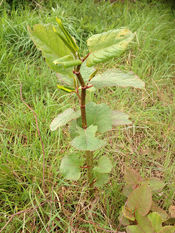
Japanese Knotweed
Fallopia japonica
What is Japanese Knotweed?
Japanese Knotweed is a perennial herbaceous plant which basically means it lives longer than two years and the stems that extend above ground are hollow. Each year new stems grow from the crown and root (rhizome) structure of the plant forming dense, leafy canopies of bamboo-like canes that can grow up to 3 metres in height. Lateral growth of the root (rhizome) network can extend on average 1 metre per year (depending on soil conditions). The root network is deep penetrating and is said to potentially extend up to 7 metres from the parent plant (14 metres in diameter) and down to 3 metres in depth.
Japanese Knotweed can occur virtually anywhere in Ireland as it can thrive in a variety of soil types. It can also pose significant risks to flooding as rivers and streams choked by Japanese Knotweed during the Summer cannot channel high water levels fast enough which can lead to localised flooding. Similarly, when the plant dies back in winter, this exposes river banks to the erosive forces of the river undermining their stability.
IMPORTANT: DO NOT CUT OR STRIM JAPANESE KNOTWEED AS THIS CAN SPREAD VIABLE PLANT MATERIAL WHICH CAN THEN GROW ELSEWHERE.






Japanese Knotweed: Facts vs. Fiction
Japanese Knotweed, the name alone has driven fear into homeowners and developers hearts for years largely due to a media fuelled campaign that has resulted in the UK mortgage industry frequently refusing mortgages on properties affected by this plant and sending property values falling by as much as 30%.
In Ireland, the impact of Japanese Knotweed management costs the economy in excess of €15 million per year on average with the construction sector bearing the majority of this cost. It is estimated that the presence of Japanese Knotweed on a development site can increase construction costs by as much as 10%, something in this day and age of inflated houses prices is not what a developer or a homebuyer wants to hear.
Of all of the media coverage you hear about Japanese Knotweed, the one that strikes home the hardest (no pun intended), is its' ability for its' roots (rhizomes) to knock down houses and cause unprecedented damage to underground services, roads, railways, footpaths, retaining walls and destabilise foundations.
The truth to this is YES and NO.
Only where a pre-existing weakness exists (cracks in brickwork, hard landscaping, underground pipes) can Japanese Knotweed rhizome cause problems as it can enter these cracks and over time, expand and become denser / tougher with age. This can put undue stress and pressure on weakened areas leading to potential future problems and should not be ignored.
What does Japanese Knotweed look like?
Japanese Knotweed goes through a variety of stages during its lifecycle but each can be easily identified if you know what to look out for and when to look out for it.
Spring
-
Thinner Red / Purple shoots emerge from the spreading of the underground root network.
-
Thicker 'Asparagus' looking shoots with reddish speckling on them emerge from mature 'crown' of the plant.
-
The reddish leaves begin to unfurl and change to their familiar bright green.
-
Fast growing juvenile 'canes' can start to be seen.
-
Later on as Spring moves into Summer, cane heights can reach 2 to 3 metres.
-
Distinctive 'shield' shape to the leaves can be identified, truncated at the base with rounded sides to a pointed tip.
-
Alternating leaf pattern along the stems, not opposite.
-
Distinctive 'bamboo' like stem structure to the canes with individual nodes separating segments of the cane.

Summer
- Established plants with canes reaching up to 3 metres in height.
- Dense, luscious looking foliage of the aforementioned 'shield' shape forming thick canopies.
- Hollow 'bamboo' like stems if broken.
- Red speckling on the stems.
- Late summer (August onwards), white / cream coloured flowers begin to appear.

Autumn
-
The dense, leafy appearance still remains however the leaves begin to yellow as Autumn draws on.
-
Leaves will begin to wilt and fall away.
-
The stems will change from their green with reddish speckling to a reddish brown then darker brown.
-
The stems / canes will remain as the leaves fall away.

Winter
-
All foliage (leaves) have wilted and fallen away leaving only the bare stems / canes behind.
-
A lot of the leftover canes will start to decompose and fall to the ground in a scattered, erratic fashion.
-
Some of the thicker, stronger canes will remain upright.
-
The canes turn a very dark brown initially and over time, will lighten in colour as they completely dry out.
-
Dried out canes are brittle once dry and split easily.





